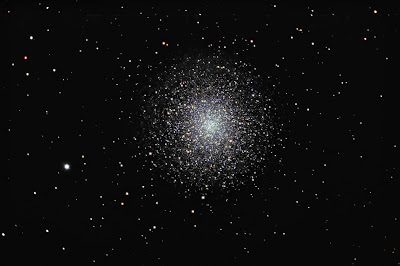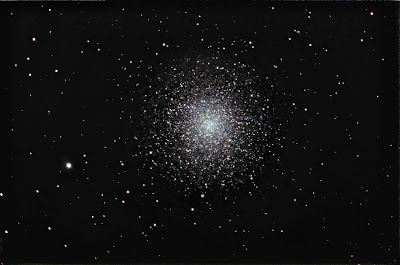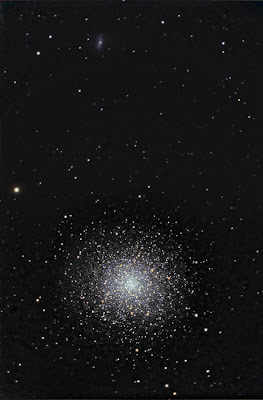COPYRIGHT, PLEASE NOTE
All the material on this website is copyrighted to J-P Metsavainio, if not otherwise stated. Any content on this website may not be reproduced without the author’s permission.
BUY A MUSEUM QUALITY POSTER
BUY A POSTER:https://astroanarchy.zenfolio.com/
Showing posts with label star clusters. Show all posts
Showing posts with label star clusters. Show all posts
Friday, September 4, 2015
Half a million stars and Messier 7
This is a second image produced as a collaboration with me and Eric Recurt. The data is shot from his observatory at Tenerife. The Observatory locates at 2400 m altitude and at 28 degrees North. The site has excellent seeing conditions, 0.8 " on average and can be below 0.3 "
Messier 7, "My God, it's full of stars!"
Be sure to click for a full size image! (Quote, 2001: A Space Odyssey)
Just right from the Messier 7 locates a dark nebula B 287. In this image is visible about 500.000 stars of our Milky Way. Click the photo to see all of them! (2100x2100 pixels)
A closeup of Messier 7
Click for a large image
Planetary nebula PN Hf2-1
Click for a large image
Planetary Nebula PN Hf2-1 is a blue dot at middle of the image area.
INFO
Technical details
Processing workflow
Deconvolution with a CCDStack2 Positive Constraint, 27 iterations, added at 33% weight
Color combine in PS CS3
Levels and curves in PS CS3.
Imaging optics
340mm F3.3 astrograph
Mount
ASA DDM 85
Cameras and filters
FLI PL 16803
Exposure times
Luminance, 11 x 300s = 55min
Red = 6 x 180s = 18min
Green = 6 x 180s = 18min
Blue = 6 x 180s = 18min
Total 1h 49min
Labels:
star clusters
Monday, April 6, 2015
A globular cluster Messier 3
I have shot couple of clusters at this Autumn season and I have published an image of Messier 13 in Hercules before. My light polluted location is not ideal for broadband targets, like clusters, but with little extra work with processing, they turned to be kind of beautiful. Image is shot at March 17. 2015.
Messier 3 (M3)
Click for a large imageLRGB shot of Messier 3
A closeup
INFO
Messier 3 (also known as M3 or NGC 5272) is a globular cluster in the constellation Canes Venatici. This cluster is one of the largest and brightest and It's located at a distance of about 33,900 light-years away from Earth. M3 has an apparent magnitude of 6.2, making it visible to the naked eye under dark conditions.
Technical details
Processing work flow
Image acquisition, MaxiDL v5.07.
Stacked and calibrated in CCDStack2.
Deconvolution with a CCDStack2 Positive Constraint, 33 iterations, added at 50% weight
Color combine in PS CS3
Levels and curves in PS CS3.
Imaging optics
Celestron Edge HD 1100 @ f7 with 0,7 focal reducer for Edge HD 1100 telescope
Mount
10-micron 1000
Cameras and filters
Imaging camera Apogee Alta U16 and Apogee seven slot filter wheel
Guider camera, Lodestar x2
Custom Scientific LRGB 50mm Square Filters
Exposure times
Luminance, 8 x 600s = 1h 20min
Red, 6 x 200s binned 2x2 = 20 min.
Green, 6 x 200s binned 2x2= 20 min.
Blue, 6 x 200s binned 2x2 = 20 min
Total 2h 20min
Labels:
star clusters
Sunday, March 22, 2015
Messier 13, the Great Globular Cluster in Hercules
The season is about to end up here 65N for about six months. We have had clear skies for a couple of weeks now and I have lots of new material to publish in near future.
Messier 13 is a kind of fast project shot between dimmer targets. My location is not ideal for a broadband targets, like galaxies and clusters, due to massive light pollution. How ever, this is my try with a M13.
Messier 13
Click for a much large image
LRGB photo of the Great Globular Cluster in Hercules. Note. galaxy NGC 6207 at a lower left corner.
Click for a much large image
LRGB photo of the Great Globular Cluster in Hercules. Note. galaxy NGC 6207 at a lower left corner.
INFO
M13 locates in constellation Hercules at a distance of 25000 light years. The Great Globular Cluster in Hercules is one of the most brightest globular star clusters in northern sky. Stars are backed to a spherical formation with a diameter of about 150 light years.
Technical details
Processing work flow
Image acquisition, MaxiDL v5.07.
Stacked and calibrated in CCDStack2.
Deconvolution with a CCDStack2 Positive Constraint, 33 iterations, added at 50% weight
Color combine in PS CS3
Levels and curves in PS CS3.
Imaging optics
Celestron Edge HD 1100 @ f7 with 0,7 focal reducer for Edge HD 1100 telescope
Cameras and filters
Imaging camera Apogee Alta U16 and Apogee seven slot filter wheel
Guider camera, Lodestar x2
Custom Scientific LRGB 50mm Square Filters
Exposure times
Luminance, 14 x 600s = 2h 20min
Red, 6 x 200s binned 2x2 = 20 min.
Green, 6 x 200s binned 2x2= 20 min.
Blue, 6 x 200s binned 2x2 = 20 min
Total 3h 20min
Labels:
star clusters
Wednesday, October 13, 2010
Tucanae 47, a Globular cluster, reprocessed
LRGB image of Tucanae, NGC 104, globular cluster in constellation Tucana.16700 light years away from Earth and 120 light years across. Image field is about 30' x 30', half a degrees.
I did reprocessed this image, since at the time I didn't have good and functional calibration files.
RCOS ja Apogee U9000 camera.
LRGB combo.
Luminance 12x300s and 8x150s, Dark and Flat calibrated.
Red 5x300s, Dark calibrated
Green 5x300s, Dark calibrated
Blue 5x300s, Dark calibrated
Raw data is shared with Petri Kehusmaa and J-P Metsavainio
Processing workflow:
Image acquisition, MaxiDL v4.xxx
Stacked and calibrated in CCDStack.
Deconvolution with a CCDSharp, 10 iterations
Levels, curves and color combine in PS CS3.
Labels:
star clusters
Saturday, June 5, 2010
An other Southern globular cluster, NGC 6752
NGC 6752, a globular cluster in constellation Pavo. Distance from Earth about 13000 light years.
100% crop from the core of NGC 6752
100% crop from the core of NGC 6752
The telescope and technical information:
16" RCOS ja Apogee U9000 camera.
LRGB combo.
Luminance 7x300s and 8x150s, Dark and Flat calibrated.
Red 1x300s, Dark calibrated
Green 1x300s, Dark calibrated
Blue 1x300s, Dark calibrated
Raw data is shared with Petri Kehusmaa and J-P Metsavainio
Processing workflow:
Image acquisition, MaxiDL v4.xxx
Stacked and calibrated in CCDStack.
Deconvolution with a CCDSharp, 10 iterations
Levels, curves and color combine in PS CS3.
Labels:
star clusters
Tucanae 47, a Globular cluster
LRGB image of Tucanae, NGC 104, globular cluster in constellation Tucana.
16700 light years away from Earth and 120 light years across.
Less compressed images here:
-
Image field is about 30' x 30', half a degrees.
A new project, from Northern galactic remote telescope in Australia.
100% crop from the core of Tukanae 47.
100% crop from the core of Tukanae 47.
The telescope and technical information:
16" RCOS ja Apogee U9000 camera.
LRGB combo.
Luminance 12x300s and 8x150s, Dark and Flat calibrated.
Red 5x300s, Dark calibrated
Green 5x300s, Dark calibrated
Blue 5x300s, Dark calibrated
Raw data is shared with Petri Kehusmaa and J-P Metsavainio
Processing workflow:
Image acquisition, MaxiDL v4.xxx
Stacked and calibrated in CCDStack.
Deconvolution with a CCDSharp, 10 iterations
Levels, curves and color combine in PS CS3.
Labels:
star clusters
Tuesday, April 8, 2008
M13-reprocessed

This image of M13 is from night of 07.03.2008.
I added some wavelets function to it under RegiStack4 software.
The difference is not huge, but dimmer outer stars are now better resolved.
Original M13 is here:
http://tinyurl.com/6cqfne
Imaging data can be found here:
Sunday, March 9, 2008
M13, second tryout

Gropped area from M13. The extended exposuretime reveals more and more dim stars around
the core.


After I was shooting Sh2-240, I moved to M13.
This is a second tryout at this season.
Weather was ok to shoot with 200mm lens, but with2000mm situation was different.
Very bad seeing and since I shoot from very center of the city, there was lots of heat current from buildings.
M13 altitude was between 30 and 45degrees. Moust of the frames are shooted trough not so thin clouds.
This time I composed image so, that I was able to placea litle galaxy, NGC 6207, at the same field of view.
There is 5 x 10min and 11 x 5min, unfiltered subs used in the image.I allso add lights from previous tryout, 7 x 15min, IDA filter. Total exp. time is three and half hours.Camera: QHY8, telescope: LX200 GPS 12", Guiding: SXV-AO+LodeStar.
Image is scaled down
Ps.
The "Shadows and Highlights" tool under Photoshop is great for targets like this!
I can pull out dimmer stars as much as I like without blowing up the core.
Subscribe to:
Comments (Atom)




















